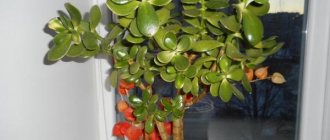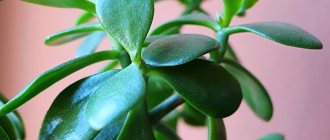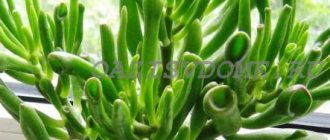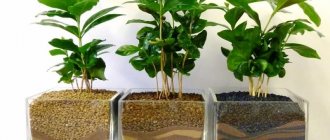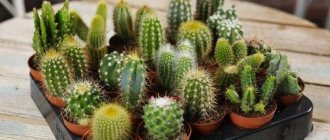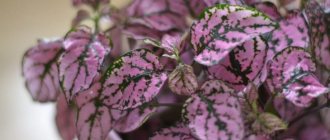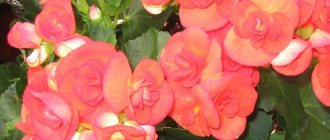Crassula (crassula) or in common people the money tree, one of the favorite indoor plants since the time of our grandmothers. The flower is unpretentious in care and not picky about the environment. It got its popular name because of the rounded shape of the leaves, reminiscent of coins.
Its African origin has given the plant strong immunity; it is practically not susceptible to diseases and pests. However, Crassula does not always please its owners with its slender trunk and lush crown. Tree leaves are especially often affected. But in most cases, this is still not a disease, but the consequences of improper care. In the text you can find out why the leaves become smaller or small areas on them may turn black, or why they turn red, wrinkle, or other symptoms occur, and what to do about it.
Why did the leaves of the crassula become unusual in appearance and what to do about it?
Thin
Crassula belongs to the family of succulents that have the properties of accumulating moisture and nutrients. The homeland of this species is countries with a hot and dry climate, so the plant makes reserves. And when there is not enough food from the outside, the fat woman begins to consume its own resources.
To restore the beauty of the elasticity of the leaves, you should change the watering regime, remove the flower from exposure to direct sunlight or heating devices, and spray.
Brown and black spots
If the spots are black and dry, then most likely the Crassula received a leaf burn. In this case, it is enough to shade the plant. Damaged leaves will not recover and will fall off over time . But the plant itself will remain beautiful and healthy.
Damaged leaves should be removed immediately to prevent the infection from spreading, and the flower itself should be treated with an antifungal drug. If the problem occurs again, treat the plant again and pay attention to the watering regime and air ventilation at the location of the flower.
Small
It is necessary to understand what exactly causes discomfort in the money tree and correct or completely eliminate the negative factor.
Reddens around the edges, from the top and bottom
Leaf color changes due to bright lighting . Contrary to its origin, the Crassula still does not like open sun. The second reason is the lack of feeding. To eliminate the problem, the plant should be rearranged and fed.
It all depends on which side of the leaf is most vulnerable at the time of solar activity.
We invite you to watch a video about redness on the fat plant:
Who is Crassula
Crassula (crassula) was born in South Africa, and received its name due to its thick and fleshy foliage. It has many varieties and is propagated in two ways: seeds and cuttings.
Crassula's homeland is South Africa.
It is believed that this plant is able to purify the air in the room where it grows, as well as bring prosperity and material wealth to the house. Crassula is called the money tree and is classified as a talisman plant.
When keeping Crassula at home, you should beware of direct rays on the foliage and stagnant air. Crassula feels best on a south-east window in a regularly ventilated room. The plant tolerates the winter period well in southern windows, and in the warm season it prefers to be in the fresh air.
The fat woman feels good on a lighted window without direct sunlight
Water the fat plant a couple of times a week if the days are hot, and at a temperature of 18–23°C, one watering is enough. In autumn and winter, it is better not to keep Crassula near heating devices, despite its tolerance to dry air.
The fat woman may not survive direct sun or the scorching heat of a radiator
Feed the fat woman no more than twice a month in the summer and once a month in the winter. The ideal fertilizer for this plant would be one that is suitable for cacti and succulents (only in a dosage reduced by half). Any fertilizing is applied to moist soil.
You can’t replant the fat plant too often. This should be done as a last resort, when the root system of the plant has already filled the pot. This usually happens once every three years. A mixture for cacti is suitable as soil for the Crassula. You need to take a shallow pot and put a drainage layer on the bottom.
The superficial root system of Crassula allows it to be grown in shallow containers
Video: caring for a fat woman
Causes of combined problems and how to fix them if such symptoms appear?
Become soft, flaccid, wrinkled and thin
If the plant is forgotten and not watered for a long time, then the leaves waste their reserves and become soft and thin . And when they suddenly remember about the flower and begin to actively water it, the leaves immediately wrinkle.
It is necessary to choose the correct watering regime, avoiding such changes in the condition of the soil. Otherwise, the flower will die from stress.
We invite you to watch a video about why Crassula can have soft leaves:
Wrinkled and blushed
The combination of these factors indicates a lack of nutrition and excessive lighting. The flower should be shaded and fed with any complex fertilizer . It is also good to spray with a biostimulant.
Soft and falling off
One of the reasons lies in watering directly from the tap. The water in this case can be quite cold. The second possible reason is excess fertilizer.
To correct both shortcomings, when watering you need to use only warm water and reduce fertilizing.
We invite you to watch a video about the reasons for the leaves falling on the fat plant and how to eliminate them:
Read more about what to do if the leaves become soft here.
Dry and fall off
If such a problem occurs, it is necessary to inspect the root system and at the same time dry the earthen ball .
If the plant is cramped in its previous pot, then it needs to be replanted.
You can learn more about the drying out of Crassula leaves and how to save the plant in this article, and read about what to do when the leaves fall off here.
We invite you to watch a video about the causes of dry foliage on Crassula:
They wither and drop their leaves
Most likely, the flower was flooded, as a result of which the root system was damaged. What to do if the leaves become soft and limp? It is necessary to dry the soil and increase the temperature. If drying the earthen coma does not produce results, then replanting the plant is required . The roots should be freed from rot, washed in a solution of potassium permanganate and only then transplanted into new soil.
You can find out more about the rotting of Crassula during flooding here.
In order for the Crassula to please with a strong trunk and a beautiful lush crown, it is necessary to carefully monitor its care. Contrary to the belief that the plant is resilient, it does not tolerate inattention and negligence in care. The main thing is not to neglect watering, protect it from bright sunlight and feed the flower on time.
Reproduction
Crassula propagates extremely easily by seeds, shoots and leaves. The last two methods are the most popular.
Seeds purchased in a store can be planted in a succulent substrate mixed in equal parts with river sand. They do not need to be buried or sprinkled. Simply shake the container so that the seeds are mixed with the soil, moisten by spraying, cover with film or non-woven material and place in a warm place. After 1.5–2 weeks, shoots will appear. Grown plants must be picked into separate cups.
With leaves and shoots everything is much simpler. Crassula often sheds its leaves on its own. After some time, you can notice that the leaf has successfully taken root. Subsequently, a new plant will emerge from it. The shoot must be planted in a ready-made moistened substrate without waiting for roots to form. Watering should be careful, without waterlogging the soil.
Photo gallery: methods of propagation of Crassula
Propagation by leaves is a method that Crassula itself uses, because the leaves easily take root in the soil. The most popular and fastest way to propagate Crassula is through cuttings of an adult tree. After the appearance of the second true leaves, Crassula shoots must be planted in separate cups. Shoots of young Crassula shoots appear 2 weeks after sowing
Why do Crassula's leaves turn pale and fall off?
to answer the question why Crassula loses its leaves . There are several possible options. As a rule, this occurs either from underwatering or from overwatering, it is also possible that your plant is experiencing stress and thus reacts to it. With the first two cases, everything is clear: if you water your pet too rarely, then it’s a drought, but if you have constantly wet soil and it doesn’t dry out, then you’ve flooded the plant.
What is the money tree afraid of?
Despite its unpretentiousness, the plant is afraid of:
- drafts;
- excessive dryness - due to loss of moisture, the leaves wrinkle and dry out;
- pests – spider mites and scale insects;
- lack and excess of lighting.
Otherwise, it is easy to care for and a beautiful, stately flower-tree.
Crassula does not grow.
Sometimes the absence of visible signs of growth is associated with the plant's dormant period, for example, in the winter in a cool room. However, there are also other reasons - lack of lighting or nutrients, as well as poor watering.
If your Crassula stands far from daylight, this is most likely the reason for the lack of growth.
The solution to the problem is very same as in the previous case - changing the location or additional lighting.
If the Money Tree stands in a well-lit place, but still does not grow, think about how often you water it, perhaps you forgot about it and the plant did not receive moisture for the second month. How long have you been fertilizing the soil?
The solution to the problem is to water the plant and then apply fertilizer (use a dosage 2 times less than indicated on the package).
Further care after pruning
The fat plant is very unpretentious and takes root immediately after pruning. Therefore, during this period it does not require special care. It is enough to place it in familiar conditions. Over the next few weeks, you should not replant the plant; you need to give it the opportunity to recover.
The process of forming the crown of a money tree is quite interesting and fascinating. And if you follow the recommendations, it’s not difficult. But the result will exceed all expectations.
dacha.expert
The leaves of Crassula have lost their elasticity. Why do Crassula leaves wither?
Crassula also withers for various reasons. Firstly, it may be simple cramped conditions in the pot , when the roots have already taken up maximum space in the container; in this case, the problem can be solved by transplanting into a more spacious pot.
Secondly, the reason that the Money Tree withers may be improperly adjusted watering . In case of flooding , the roots of the plant crack and begin to rot, and the trunk begins to rot along with them, causing the leaves to wither and wrinkle. Unfortunately, simply reducing watering will not solve the problem . It is necessary to remove the plant from the pot and inspect its root system. If the earthen ball around the roots is wet and the roots are rotten, then they will have to be removed. You need to use new soil for Crassula, and in future do not water it so much. Unfortunately, transplanting Crassula is not a guarantee that she will survive . If, after time, she does not get better, we advise you to break off the cutting and root it. Don't worry, succulents are very easy to propagate.
The soil
The most suitable soil for Crassula is a special ready-made substrate for succulents. It is very loose and light, designed for delicate roots. Such soil easily allows water and air to pass through. But you can prepare the soil yourself. To do this, you will need equal parts of leaf soil, turf soil and coarse sand. To quickly remove excess moisture, the pot must have a drainage layer of at least 4 cm.
The substrate for Crassula should be airy and light
The roots of the Crassula rot - the trunk softens and the leaves wrinkle.
If, when replanting your wilting plant, you see that the roots of the Crassula have darkened and begun to rot , but you need to take a number of resuscitation measures, otherwise the plant will die very quickly.
So, first, rinse the Crassula roots under running warm water. Secondly, remove the damaged areas of the roots. Thirdly, prepare a weak solution of potassium permanganate and place the Crassula with the remaining roots in it for 15-20 minutes. This is necessary in order to disinfect healthy roots.
Beneficial features
The leaves contain phytoncides and flavonoids. Crassula is beneficial even if it just stands indoors:
- the air in the room is purified, pathogenic microorganisms living in it are destroyed;
- in the room where there is a flower, it is easy to sleep, it is pleasant and peaceful to be;
- performance increases, mood improves;
- If there is a money tree in the house, people are much less likely to get seasonal colds.
It is the leaves of the plant that bring the greatest benefit. They are used in the treatment of a wide variety of diseases, including:
- varicose veins;
- haemorrhoids;
- angina;
- herpes;
- nail fungus;
- cold;
- cough;
- runny nose;
- cystitis;
- inflammation of the genitourinary system;
- dental diseases;
- joint diseases.
Crassula creates a favorable microclimate indoors and is beneficial when used outdoors. The juice of the leaves of the plant helps relieve inflammation and accelerates the healing process of infected scratches and wounds.
At the same time, it eliminates even severe itching and alleviates painful symptoms of various diseases. If you take the juice of Crassula leaves orally, but in minimal quantities, you can normalize the functioning of the intestines and stomach, and in case of cystitis, internal inflammation is relieved.
The plant is of great benefit during colds. You can prepare an infusion of the leaves to gargle a sore throat or instill the remedy for nasal congestion.
Crassula has black spots. What is this?
In the case of blackening of Crassula leaves, there are 2 options that must be distinguished. It could be a simple sunburn or a completely unusual infection that will destroy your plant in a matter of days or weeks. How to distinguish a burn from an infection? Carefully inspect the affected areas. A burn is always a local phenomenon , and will appear only in the place where the sun's rays directly hit . Solve the problem by simply changing the location of your plant.
If you find blackheads in hard-to-reach places where the sun could not reach in principle, but you are dealing with a bacterial infection.
Fungal infection of Crasula and how to treat it?
You need to follow simple recommendations - reduce watering or eliminate it completely. Ventilate the room more often. And the most important thing is to transplant the Crassula.
The transplant must be carried out according to the following rules:
- rinse the roots under warm water
- remove old and rotten roots
- soak the plant in a solution of potassium permanganate for up to 20 minutes.
- disinfect the pot by washing it with a soapy solution using laundry soap, and dousing it with hot water.
- prepare new soil and transplant Crassula there.
Sometimes, the plant is damaged by more than half, and it is not possible to save it; in this case, it is better to remove the still healthy cuttings and root them. Crassula reproduces like other succulents - by rooting cuttings or leaves.
You might be interested in:
A white (silver) coating appeared on the leaves of Crassula.
If you find a white or silvery coating on the leaves of Crassula , inspect your plant carefully. If no additional symptoms are found, perhaps this is due to the stress your Crassula has experienced and thus she is simply recovering . In this case, she does not need your intervention!
White dots on Crassula leaves.
If you find other symptoms on your plant, for example: mealy discharge in the axils of the leaves or roots, then most likely it is a pest that has settled on your plant - mealybug .
The Money Tree is not believed to be susceptible to insect pests. This is not entirely true. A plant with a weakened immune system can still suffer from various pests. And then you need to know how to save him.
Insect pests
Plant parasites are something that any indoor plant grower faces, including the owner of a money tree. Dealing with pests is much easier than dealing with bacteria or fungi.
Shchitovka
The scale insect is quite easy to detect: light brown tubercles or spots with a yellow tint can be seen on the surface of the leaf and stem.
It's not difficult to fight her. Insects are collected by hand, and then the plant is treated with a soap solution or Fitoverm. This bio-product must be used according to the instructions; it is safe for humans and plants, but extremely effective against plant pests.
The scale insect on the Crassula leaves clear signs of its presence
Spider mite
Spider mites are very small insects that cause enormous damage to the plant. Despite its small size, the tick can be seen with the naked eye. It looks like a small gray or red dot that is in constant motion. A clear manifestation of a mite attack is a cobweb enveloping the leaves of the fat plant, as well as yellowing or browning of the leaves.
Spider mites leave visible marks on the occupied plant
If you find a tick on the Crassula, you should immediately spray the plant and immediately put a bag on the Crassula, tightening it on the pot. In conditions of high humidity, the tick will die. Other means to combat the pest are a soap solution or the Apollo preparation.
Mealybug
This is a fairly frequent visitor to the Crassula. It likes to be located on the roots and in the axils of leaves, feeding on plant tissues and gradually weakening the bush’s immunity. In addition, it spoils the appearance of Crassula, covering the greens with powdery secretions that resemble cotton wool.
The mealybug on the Crassula is visible to the naked eye
The scale insect is easily washed off the foliage with a stream of water. After getting rid of insects, Crassula is treated with a cotton swab dipped in an alcohol solution or garlic infusion. The drugs Fufanon and Actellik also cope well with the pest.
Root mealybug
The root bug settles on the roots of the fat plant. It's not easy to find him there. This usually happens during the spring transfer of the plant to another pot.
If a scale insect attacks, you should wash the roots of the plant under running water (temperature 50°C), and then treat the root bundle in a solution of Fufanon or Actellik (twice with an interval of 7–8 days).
The root bug unfolds its activity inside the root system
Spider mite.
This parasite is very easy to identify - by the characteristic cobweb on the plant. You can also see it by looking closely at the plant - you should see a gray or red dot that moves along the leaf.
Spider mites are very afraid of high humidity. You can fight it using the folk method:
- Give your plant a warm shower.
- prepare a soap solution using laundry soap.
- foam the solution and apply the foam to the leaves and trunk.
- wash off the foam
- Place the plant under a hood or plastic bag to maintain high humidity.
- It is better to repeat the procedure again after a week.

